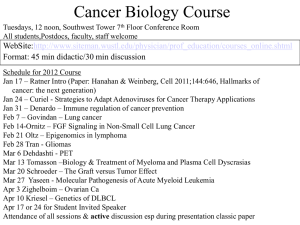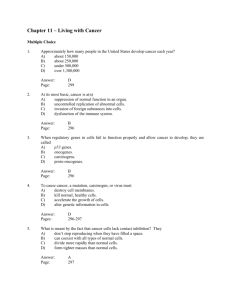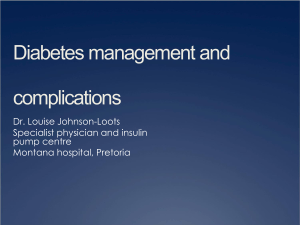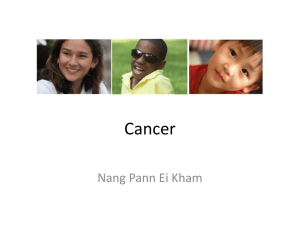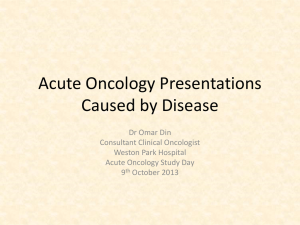Chap11, Ch11
advertisement
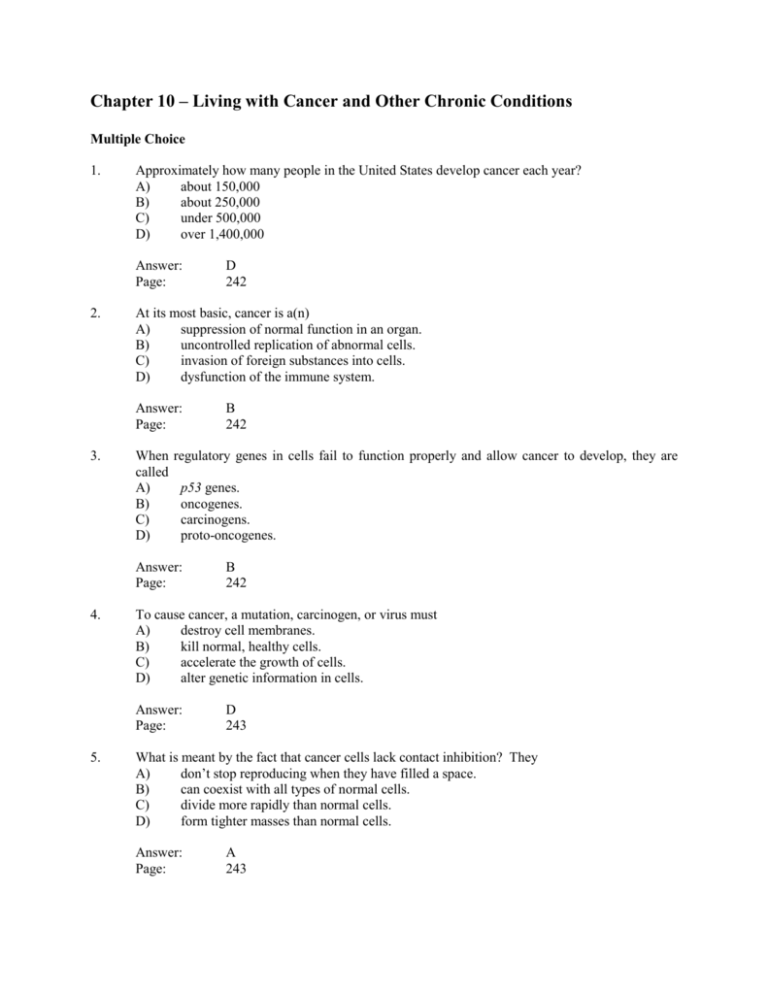
Chapter 10 – Living with Cancer and Other Chronic Conditions Multiple Choice 1. Approximately how many people in the United States develop cancer each year? A) about 150,000 B) about 250,000 C) under 500,000 D) over 1,400,000 Answer: Page: 2. At its most basic, cancer is a(n) A) suppression of normal function in an organ. B) uncontrolled replication of abnormal cells. C) invasion of foreign substances into cells. D) dysfunction of the immune system. Answer: Page: 3. When called A) B) C) D) p53 genes. oncogenes. carcinogens. proto-oncogenes. B 242 To cause cancer, a mutation, carcinogen, or virus must A) destroy cell membranes. B) kill normal, healthy cells. C) accelerate the growth of cells. D) alter genetic information in cells. Answer: Page: 5. B 242 regulatory genes in cells fail to function properly and allow cancer to develop, they are Answer: Page: 4. D 242 D 243 What is meant by the fact that cancer cells lack contact inhibition? They A) don’t stop reproducing when they have filled a space. B) can coexist with all types of normal cells. C) divide more rapidly than normal cells. D) form tighter masses than normal cells. Answer: Page: A 243 6. Metastasis is the term used to describe the cancer cell’s ability to A) spread to other sites in the body. B) protect itself from toxic substances. C) escape detection by the immune system. D) command extra blood supply from the circulatory system. Answer: Page: 7. One of the dangerous properties of cancer cells is that they A) ingest normal cells. B) can live indefinitely. C) grow larger than normal cells. D) can kill other cells on contact. Answer: Page: 8. B 244 In the United States, the most commonly occurring malignant cancers are A) carcinomas. B) melanomas. C) leukemias. D) sarcomas. Answer: Page: 11. C 244 When doctors use terms such as carcinoma, sarcoma, and melanoma to describe cancers, they are naming them according to the A) speed at which they spread. B) basis of their cell type. C) TNM staging system. D) rate at which they are cured. Answer: Page: 10. B 243 A tumor that does not spread to other sites in the body is labeled A) proto-oncogenic. B) inoperable. C) benign. D) local. Answer: Page: 9. A 243 A 244 You can reduce your risk of developing melanoma by A) avoiding cigarettes. B) abstaining from alcohol use. C) avoiding exposure to carcinogenic chemicals. D) protecting yourself from excessive exposure to the sun. Answer: Page: 12. Hepatoma is cancer of the A) endocrine system. B) immune system. C) connective tissue. D) liver. Answer: Page: 13. C 249 What percentage of lung cancer victims are smokers? A) about 50 percent B) 65-75 percent C) 85-90 percent D) over 95 percent Answer: Page: 16. B 245, 249 Which of the following is TRUE of people who have a hereditary risk of developing lung cancer? A) They are genetically destined to have lung cancer. B) They will have lung cancer if they become smokers. C) If they do not smoke, they lower their lung cancer risk significantly. D) Smoking is less significant as a lung cancer risk factor for them. Answer: Page: 15. D 244 Which of the following is the MOST lethal form of cancer for women? A) breast B) lung C) ovarian D) cervical Answer: Pages: 14. D 244 C 249 A Gail score of 1.66 percent indicates A) low risk for breast cancer. B) high risk for breast cancer C) that a prophylactic mastectomy is required. D) that the cancer is inoperable. Answer: Page: B 253 17. Which of the following is NOT a risk factor for developing breast cancer? A) women whose menstrual period began at a later age B) women who have had no children C) women whose diet is high in fat D) women who have used hormone replacement therapy Answer: Page: 18. Cheyenne learns from genetic screening that she has a mutated version of the BRCA1 gene. She also has a family history of breast cancer. The LEAST helpful recommendation for her is A) a prophylactic mastectomy. B) frequent, thorough examinations for breast cancer. C) preventive drug therapy, if judged appropriate by her doctor. D) breast self-examination and annual mammograms beginning at age 50. Answer: Page: 19. A 254 Which type of skin cancer presents as a painless bump and is often mistaken for a cyst? A) melanoma B) basal cell C) Merkel cell carcinoma D) squamous cell Answer: Pages: 22. A 253 The most effective tool for identifying breast cancer is A) mammography B) a family history C) self-examination D) genetic screening Answer: Page: 21. D 253 A prophylactic mastectomy is A) removal of healthy breast tissue to avoid the risk of breast cancer. B) a mastectomy that includes the immediate insertion of a breast implant. C) removal of all breast tissue and nearby lymph nodes to treat breast cancer. D) removal of the cancerous lump itself and a small amount of surrounding tissue. Answer: Page: 20. A 252 C 248-249 The most effective and currently available screening method for cervical cancer is A) X-ray. B) the Pap test. C) HPV screening. D) a vaginal blood test. Answer: Page: 23. Which drug therapy is highly effective for women whose type of breast cancer was stimulated by the presence of estrogen? A) herceptin B) hormone replacement therapy C) cisplatin D) tamoxifen Answer: Page: 24. D 258 Blood clots, endometrial cancer, stroke, and cataracts are all possible side effects of which class of drugs that is used to treat breast cancer? A) aromatase inhibitors B) estrogen receptor modulators C) beta blockers D) GVAX Answer: Page: 27. C 257 Sheryl has many sexual partners but wants to avoid cervical cancer. Besides regular Pap tests, she could BEST lower her risk by which of the following? A) taking up smoking B) abstaining from alcohol C) taking a prescription antibiotic D) using condoms Answer: Page: 26. D 253 The Pap test is the A) use of a dye to enable X-ray identification of precancerous cells. B) endoscopic examination of the uterine lining for abnormalities. C) removal of a sample of cervical cells for examination. D) screening blood samples for cancer cell markers. Answer: Page: 25. B 257 B 253 Uterine cancer is cancer of the A) cervix. B) ovaries. C) vaginal canal. D) wall of the uterus. Answer: Page: D 259 28. The principal risk factor related to the development of uterine cancer is A) high estrogen levels. B) early menopause. C) multiple sexual partners. D) late onset of menstruation. Answer: Page: 29. Thirty-five-year-old Tara is considering having her ovaries surgically removed to avoid the risk of ovarian cancer. In which of the following cases would this make the most sense? A) She is unmarried. B) She has had more than six children. C) Her family has a strong history of ovarian cancer. D) She was exposed to the drug DES before birth. Answer: Page: 30. B 256 The greatest risk factor for prostate cancer among men is A) age. B) obesity. C) dietary fat intake. D) sexual promiscuity. Answer: Page: 33. D 260 Which of the following is the second leading cause of cancer deaths among American men? A) lung cancer B) prostate cancer C) testicular cancer D) colorectal cancer Answer: Page: 32. C 260 Women in whom ovarian cancer has been diagnosed often report that the only symptoms were A) sharp abdominal pains that are strongest during activity. B) the disappearance of the sex drive. C) nausea and vomiting. D) digestive disturbances. Answer: Page: 31. A 259 A 256 One of the most common symptoms of prostate cancer is A) abdominal pain. B) difficulty in urinating. C) nausea and vomiting. D) loss of sexual function. Answer: Page: 34. Which of the following types of solid tumors are most common among young men? A) breast B) prostate C) testicular D) colorectal Answer: Page: 35. B 257 Fred detects a small lump on one of his testicles and naturally wonders if he has cancer. He should be most suspicious if it A) is painless. B) is painful to the touch. C) disappears the following day. D) becomes larger and softer the following day. Answer: Page: 38. C 257 Treatment for testicular cancer most commonly includes A) removal of both testicles and the prostate gland. B) removal of the affected testicle. C) chemotherapy. D) radiation. Answer: Page: 37. C 257 The most important early detection measure for testicular cancer in men is A) a urinalysis. B) a yearly X-ray. C) self-examination. D) a yearly blood test. Answer: Page: 36. B 256 A 257 The second leading cause of cancer deaths in males is ___________ cancer. A) colon B) kidney C) lymphatic D) skin Answer: Page: A 250 39. Small precancerous pouchings in the wall of the lower intestinal tract are called A) nodes. B) polyps. C) lesions. D) cystolas. Answer: Page: 40. The use of food, food products, or medications to bolster the immune system or reduce the damage caused by carcinogens is termed A) chemoprevention. B) chemonutrition. C) chemointervention. D) chemotherapy. Answer: Page: 41. A 260 The most effective step toward preventing pancreatic cancer is to A) consume no more than three alcoholic drinks a day. B) eat more dietary fiber. C) drink large quantities of fluid a day. D) stop smoking. Answer: Page: 44. B 250 Pancreatic cancer is more common in A) African American men. B) Hispanic women. C) Asian women. D) Caucasian men. Answer: Page: 43. A 263 Thirty-five-year-old Ken experienced a change in bowel habits, and a stool test revealed abnormal amounts of blood. The most likely next step for Ken is A) chemotherapy. B) a colonoscopy. C) radiation treatments. D) surgical removal of the colon. Answer: Page: 42. B 250 D 260 Your 56-year-old brother has been diagnosed with pancreatic cancer. Which of the following scenarios is most likely? A) He has only a five percent survival rate five years after diagnosis. B) The disease will go into spontaneous remission. C) D) He will die of another cause before this becomes lethal. He will be cured if he receives appropriate medical treatment. Answer: Page: 45. One of the main difficulties in detecting lymphatic cancer is that A) it is hard to diagnose. B) there are no noticeable symptoms. C) people are afraid to report it to their doctors. D) the symptoms are similar to those of less serious illnesses. Answer: Page: 46. B 261-262 The major cause of skin cancer is A) excessive use of zinc oxide skin lotions. B) lack of exposure to sunlight. C) chronic exposure to sunlight when young. D) aging. Answer: Page: 49. A 261 Treatment of lymphomas most commonly includes A) surgery. B) radiation. C) chemotherapy. D) organ transplantation. Answer: Pages: 48. D 261 Which of the following is an effective method of preventing lymphoma? A) Little can be done to prevent lymphoma. B) a program of regular exercise C) avoiding cigarettes and alcohol abuse D) avoiding cigarettes and reducing dietary fat intake Answer: Page: 47. A 260 C 247 To protect your skin from unhealthy exposure to the sun’s rays, you should use a sun block lotion with a skin protection factor (SPF) of at least ______. A) 5 B) 10 C) 15 D) 20 Answer: Page: C 247 50. Which of the following is largely responsible for skin cancer? A) occupational exposure to hydrocarbons B) severe sunburning during childhood C) use of artificial tanning creams D) using an SPF of 10 or less Answer: Page: 51. Sam enjoys outdoor activities. Which of the following is NOT a recommendation to help him prevent skin cancer? He should A) use an SPF of 15 or greater. B) limit his outdoor activities between 11:00 AM-2:00 PM. C) wear a hat. D) make sure he is well hydrated. Answer: Page: 52. D 248 When melanoma is found at an early stage, the cure rate is _________ percent. A) 35 B) 99 C) 50 D) 89 Answer: Page: 55. B 247 When malignant melanoma is identified at an early stage, it is most commonly treated by A) surgical removal and chemotherapy. B) surgical removal and radiation. C) radiation and chemotherapy. D) surgical removal alone. Answer: Page: 54. D 247 To help you to identify malignant melanoma, the American Cancer Society recommends that you use the mnemonic ABCD, which stands for A) Abnormal appearance, Blended edges, Color Dark. B) Asymmetry, Border irregularity, Color change, Diameter >6mm. C) Assorted shapes, Blended edges, Color change, Denser than surrounding tissue. D) Abnormal size, Black or nearly black, Changing shape, Denser than surrounding tissue. Answer: Page: 53. B 247 B 248 The most important factor in the treatment of most cancers is A) overall fitness level. B) a positive attitude. C) D) family support. early detection. Answer: Page: 56. Klinefelter’s syndrome may occur when A) an extra female sex chromosome is present. B) a sex chromosome is missing. C) an extra autosome is present. D) an autosome is missing. Answer: Page: 57. B 268 Which of the following is NOT a serious medical problem associated with sickle-cell disease? A) anemia B) congestive heart failure C) gall bladder infections D) recurrent pneumonia Answer: Pages: 60. B 268 You are a carrier of the sickle-cell gene. How will this affect your health? A) It will shorten your life expectancy. B) It will have almost no effect on your health. C) You will be susceptible to frequent infections. D) You will have one chance in four of developing sickle-cell disease. Answer: Page: 59. A 252 Sickle-cell disease is most prominent in A) Hispanic Americans. B) African Americans. C) Eastern European Jews. D) Caucasians. Answer: Page: 58. D 251 (Table 10.3) D 269-270 In sickle-cell disease, the characteristic sickle-shaped cells are A) genetic flaws in certain types of white blood cells. B) congenital abnormalities in blood vessel walls. C) elongated and unable to pass through the body’s minute capillaries. D) cancerous cells in the bone marrow. Answer: Page: C 268 61. A form of dementia caused by the gradual loss of brain function is referred to as A) Parkinson’s disease. B) Alzheimer’s disease. C) Crohn’s disease. D) Turner’s syndrome Answer: Page: 62. Both major types of diabetes occur because of A) too much sugar in the blood. B) too much insulin in the blood. C) the body’s insensitivity to insulin. D) the body’s inability to regulate blood sugar. Answer: Pages: 63. C 266 Which organ produces insulin? A) pancreas B) liver C) kidneys D) large intestines Answer: Page: 66. B 266 One of the major warning signs of type 2 diabetes is A) kidney failure. B) abdominal pain. C) increased thirst. D) a craving for sweets. Answer: Page: 65. D 266-268 Hyperglycemia occurs when A) the blood contains an abnormally low amount of glucose. B) excessive amounts of glucose accumulate in the blood. C) abnormal quantities of glucose pour into cells. D) the body cannot produce enough insulin. Answer: Page: 64. B 269 A 266 Type 1 (insulin-dependent) diabetes occurs when the A) body becomes insensitive to insulin. B) body loses its ability to produce insulin. C) pancreas starts to release an ineffective form of insulin. D) body develops a hypersensitivity to insulin and excretes most of it in the urine. Answer: Page: 67. The cause of type 1 diabetes is the destruction of insulin-producing sites by A) a viral infection. B) mutated pancreatic cells. C) one’s own immune system. D) excessive levels of blood glucose. Answer: Page: 68. B 268 It has recently been discovered that people who suffer from diabetes are more likely to develop which of the following disorders? A) Parkinson’s disease B) cystic fibrosis C) Alzheimer’s disease D) Crohn’s disease Answer: Page: 71. C 268 Your friend Hal recently developed type 1 diabetes. He takes his insulin as prescribed, but he will not stop smoking or stay on the diet his doctor recommended. What is the MOST likely risk? He could A) rapidly become obese. B) make the disease worse. C) begin to lose bone and muscle mass. D) develop an insensitivity to the insulin. Answer: Page: 70. C 268 Which of the following is NOT a means for people with type 1 diabetes to take their insulin? A) injection B) nasal inhalation C) dietary supplements D) transdermal patches Answer: Page: 69. B 268 C 268 One method for monitoring diabetes involves measuring the amount of glycated hemoglobin in the blood. A reading above 7 mg/dl indicates A) glucose intolerance. B) that it is within normal measures. C) insulin sensitivity. D) that it is borderline high. Answer: Page: A 267 72. Which of the following is NOT a symptom of the advanced stage of Alzheimer’s disease? A) loss of bladder function B) infantile behavior C) loss of bowel function D) mild depression Answer: Page: 73. A type of inflammatory bowel disease in which there is an erosive deterioration of the inner surface of the intestinal wall is ____________ disease. A) Kapler’s B) Conan’s C) Cooper’s D) Crohn’s Answer: Pages: 74. C 263-264 The damage caused by multiple sclerosis centers on the A) acceleration of the physical process of aging. B) disruption of circulation in the extremities. C) collapse of the immune system. D) destruction of nerve tissues. Answer: Page: 77. D 263 In addition to drug therapy, an important component of lupus treatments is A) vigorous exercise. B) surgical removal of the pancreas. C) avoidance of exposure to sun, fatigue, or infectious disease. D) exposure to sunlight to promote vitamin D absorption. Answer: Pages: 76. D 264-265 An autoimmune disease that is characterized by the immune system’s attack on connective tissues is A) Crohn’s disease. B) multiple sclerosis. C) Parkinson’s disease. D) systemic lupus erythematosus. Answer: Pages: 75. D 269 D 265 Which of the following is FALSE regarding treatment of multiple sclerosis? It is aimed at A) curing the disease. B) reducing the severity of the symptoms. C) D) extending the period of remission. providing emotional support as the disease progresses. Answer: Page: 78. A 265 A precise diagnosis of Alzheimer’s disease is during A) an autopsy. B) an MRI or PET scan. C) a memory test. D) a blood test. Answer: Page: A 269 True/False 79. There is no known genetic link to cancer. Answer: Pages: 80. The p53 gene is missing or altered in half of all cancers. Answer: Page: 81. False 243 Cancer cells have the ability to command the circulatory system to send them additional blood supply to meet their metabolic needs. Answer: Page: 84. True 242 Cancer cells have an indefinite life span due to the enzyme telomerase. Answer: Page: 83. True 242 Cancer-causing genes are called oncogenes. Answer: Page: 82. False 242-243 True 243 Both breast cancer and lung cancer are forms of carcinoma. Answer: Page: True 244 85. Only 30 percent of people with lung cancer survive five years beyond diagnosis. Answer: Page: 86. More than 85 percent of all cases of lung cancer occur in smokers. Answer: Page: 87. True 259 Surgical removal of the ovaries is not currently an option for ovarian cancer patients. Answer: Page: 94. False 257 A woman’s risk of developing uterine cancer is strongly linked to high levels of the hormone estrogen in her system. Answer: Page: 93. True 254 The association between sexually transmitted infections (STDs) and cervical cancer is unclear. Answer: Page: 92. True 253 Mammography is the best early detection tool for breast cancer. Answer: Page: 91. False 249 Prophylactic mastectomy attempts to eliminate the possibility of future cancer development. Answer: Page: 90. True 249 Breast cancer is the leading cause of death from cancer in women. Answer: Page: 89. True 249 Some people have a genetic predisposition to develop lung cancer. Answer: Page: 88. False 249 False 260 Because of its vague symptoms, ovarian cancer is referred to as a “silent cancer.” Answer: Page: True 260 95. Frequent urination, especially at night, is a symptom of prostate disease. Answer: Page: 96. There may be a genetic link to prostate cancer. Answer: Page: 97. False 248 Proper diet and exercise can lower your cancer risk. Answer: Page: 104. True 248 Weight loss is one of the seven early warning signs of cancer. Answer: Page: 103. False 261 The cure rate for non-melanoma types of skin cancer is nearly 100 percent. Answer: Page: 102. False 261 The early symptoms of lymphoma are unique. Answer: Page: 101. True 250 Cancer of the pancreas is generally treated by surgical removal of the pancreas. Answer: Page: 100. False 257 The incidence of colorectal cancer tends to run in families. Answer: Page: 99. True 256 Regardless of the stage at which it is detected, testicular cancer has a poor survivability rate. Answer: Page: 98. True 256 True 263 Almost eight percent of African Americans are victims of sickle-cell disease. Answer: Page: False 268 105. Type 2 (non-insulin-dependent) diabetes mellitus causes glucose levels in the blood to rise. Answer: Page: 106. In type 1 diabetes, the body does not produce insulin. Answer: Page: 107. False 263 Multiple sclerosis is marked by the deterioration of nerve cells. Answer: Page: 112. True 263 Systemic lupus erythematosus is an autoimmune disorder that occurs primarily among men. Answer: Page: 111. False 266 In an autoimmune disorder, the immune system attacks the body’s own tissues. Answer: Page: 110. True 268 The use of bone marrow stem cells has had no impact on the treatment of MS. Answer: Page: 109. True 268 Without proper management, diabetes can lead to premature death. Answer: Page: 108. True 266 True 265 Whether a patient has Alzheimer’s disease cannot be completely confirmed before death. Answer: Page: True 269 Essay 113. Cancer is a destructive disease. Describe its impact on the body. Answer: Because cancer cells are abnormal cells, they do not function properly in their tissues of origin, so they do not support body functions. Further, because cancer cells lack contact inhibition and do not die, they eventually begin to crowd out healthy cells. Finally, cancer cells spread to other sites in the body, multiplying the problem. Pages: 243-244 114. What prevention methods are available to reduce your risk for contracting skin cancer? Answer: The risk factors associated with skin cancer are severe sunburning during childhood and chronic sun exposure during adolescence and young adulthood. Prevention methods include using an SPF of 15 or greater, limiting sun exposure between 11:00 AM and 2:00 PM, and wearing protective clothing (e.g., hat, t-shirt). Page: 115. 247 Why is lung cancer the leading cause of cancer deaths? Answer: The main reason lung cancer kills so many is that smoking is a popular habit, and smoking often leads to lung cancer because of the manner in which tobacco smoke invades the lungs with toxins. The nature of lung cancer is such that it usually cannot be diagnosed until it is in an advanced stage; therefore, survival rates are very poor. Page: 116. 249 Describe the risk factors for breast cancer. Answer: Women who have a family history of breast cancer run a higher risk than women who do not. Other risk factors include women: 1) whose menstrual periods began early or whose menopause occurred late; 2) who have had no children or had their first child later in life; 3) have used hormone replacement therapy; 4) who are sedentary, have excessive central body cavity fat, or have diets high in saturated fats; 5) who have inherited certain mutated genes, including the tumor suppressor genes BRCA1 and BRCA2. Page: 117. 252 Explain the importance of the Pap test. Answer: The Pap test is an early detection method for cervical cancer that can identify precancerous changes in tissues before they actually become cancers. It is an effective and easily administered test. When used with regular screening, the vast majority of cervical cancer cases can be not only identified but prevented. Page: 118. 257 What are the warning signs of cancer? Answer: The warning signs of cancer include: 1) changes in bowel or bladder habits; 2) a sore that does not heal; 3) unusual bleeding or discharge; 4) thickening or lump in the breast or elsewhere; 5) indigestion or difficulty in swallowing; 6) obvious change in a wart or mole; 7) nagging cough or hoarseness. Page: 119. 248 (Table 10.2) Explain how lifestyle changes can reduce your cancer risk. Answer: Quitting or avoiding smoking can reduce most of the risk for lung cancer and other smoking-related cancers of the mouth and respiratory tract. Avoiding carcinogens in the environment, especially in the workplace, is also an important prevention measure. A healthy diet and weight control can also have a preventative effect, as can regular exercise. Limiting exposure to the sun will slow the development of skin cancer. Avoiding heavy use of alcohol can also lower the risk of some cancers. Know your family history for cancer, and be aware that early screening for certain cancers may be appropriate in this situation. Pages: 120. 262-263 Describe the similarities and differences between type 1 and type 2 diabetes mellitus. Answer: Similarities: Both occur because insulin is unable to facilitate the transport of glucose into body cells; both result in excess blood glucose; the symptoms and long-term damage are generally the same. Differences: Type 2 diabetes features normal insulin production, while type 1 is marked by the absence of insulin production. Type 1 diabetes always requires regular doses of insulin from an outside source. Pages: 121. 266-268 Describe the progress of Alzheimer’s disease. Answer: Early symptoms include mild depressive behavior and occasional absent-mindedness. As the disease progresses, the victim will still appear physically healthy, but memory loss becomes more pronounced, and the victim may often appear confused. In later stages, victims are unable to care for themselves and eventually become incapacitated. Pages: 269-270
